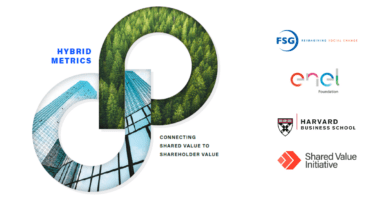Build it back better. That has become the mantra of recovery from this extended crisis. One area that has started to change is the quarterly earnings call. This key disclosure forum has been rightly criticized for amplifying short-term pressures that create incentives for short-term profit taking at the expense of employees, research and development, and sustainability.
Our joint research by NYU Stern Center for Sustainable Business (CSB) and the CEO Investor Forum, before the coronavirus hit, found that analysts were generally not familiar with environmental, social and governance issues that were material for the company, not least because the company did not bring them up in the quarterly calls. CEOs said that analysts did not ask for the information; analysts said that if the CEOs were not providing it, then it couldn’t be that important[1].
This is a picture familiar to FSG who identify the problem of “two separate narratives” in corporate disclosure with “one telling how profitable a company is, and the other highlighting whether the company is good for people and planet” – but without a consolidated narrative that says how these elements interact. In the context of the earnings call, explaining how ESG is the precursor of financial performance is key.
The coronavirus is disrupting the earnings call – as it is everything else. The crisis is shining a light on the “S” in terms of challenges with labor and working conditions, and climate change is already creating significant “E” risk for companies ranging from coal to coffee. Recent surveys of Q1 and Q2 earnings seasons suggest a significant up-tick in ESG content being shared[2]. As such, now is a good time for issuers to engage with our recommendations, in concert with those in FSG’s Hybrid Metric Reports.
Some executive-ready recommendations
Working with professionals from Investor Relations, Strategy, and Corporate Sustainability functions from more than a dozen companies, we built a framework and set out practical recommendations for issuers to better integrate ESG strategy and the impact of ESG performance into the earnings call.
Integrate content sequentially: Begin to integrate ESG and long-term strategy content into existing disclosures in a manner that builds comfort and confidence within the investor base and management. Explain management’s thesis regarding the impact of ESG strategy and performance on the company’s financial performance. Companies can start with outlining the impacts of simple cost-avoidance approaches, where the bright line between the ESG initiative and the financial outcome is more readily discerned such as energy savings due to climate commitments. Additionally, a company could include an assessment (and specific examples) of the value at risk associated with not acting on a particular material ESG theme (e.g., supply chain disruptions due to climate change).
Monetize and Report on the Return on ESG Investment: Disclosing ESG progress alone will not be of interest to analysts, instead, set out the longer-term plan at the outset by explaining the material ESG issues the company is managing for. Then report on the financial impact of your ESG efforts as appropriate. In other words, if you are investing in your employees to reduce attrition, report on how much money you have saved through improvements in retention rates.
Adapt the earnings call schedule: Develop a plan for how you will use each of the four calls in a year. For example, provide quarterly updates on key ESG performance and ESG-driven financial measures, or use one of the four quarterly calls to provide a deeper discussion of ESG, or deploy the CEO segment for macro framing on purpose and stakeholder approach.
Nestle has featured key elements of their shared value and sustainability approach on earnings calls since Q1 2019. A key part of these steps is to prime the sell-side analysts (the most vocal participants on the earnings call) to ask questions relevant to the corporation’s ESG story.
Develop cross-function collaborations: Disclosure often operates as a forcing function within a company; having to disclose new things means you have to do new things[3]. Over time, this process can make you a better-managed and more resilient company. For example, Investor Relations and Corporate Sustainability need to co-develop content, and the CFO team is going to have to engage more deeply on ESG themes and impacts (eg IWAI)[4] – developing a deeper understanding of the origins and dependencies of corporate value.
Conclusion
Our experts saw that issuers could use the reporting flexibility available to them to signal a long-term outlook, demonstrate the value of investments in ESG, and explain the alignment between ESG, long-term strategy, and the strategic priorities of structurally long-term investors. Sound ESG performance on material ESG issues will increasingly be seen as “table stakes.” Over time, management teams will look to leverage differentiated sustainability strategies as a source of competitive advantage, which investors will look to value. These are tough but necessary steps and the best way to get there is to get started.
[1] https://papers.ssrn.com/sol3/papers.cfm?abstract_id=3607921
[2] https://www.irmagazine.com/reporting/opinion-why-you-should-discuss-esg-earnings-call
[3] https://papers.ssrn.com/sol3/papers.cfm?abstract_id=3332342
[4] https://www.hbs.edu/impact-weighted-accounts/Pages/default.aspx




